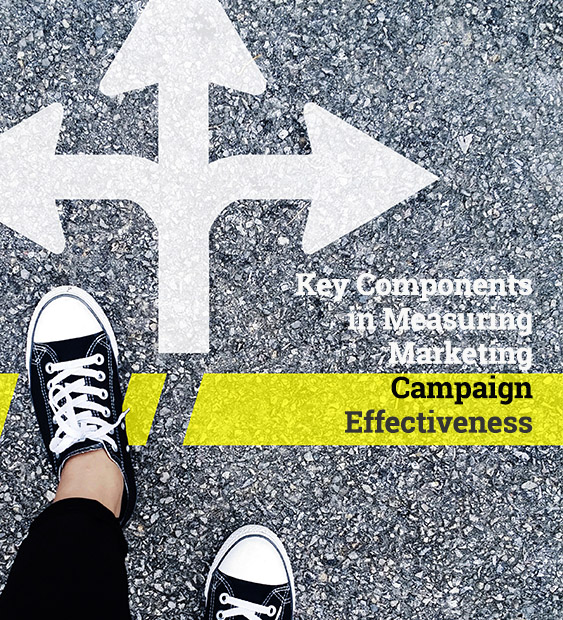Many marketers still don't have the proper knowledge of how to utilize attribution models successfully. As many as 58% of marketing teams say that their lack of knowledge regarding appropriate implementation and execution of attribution models prevents them from pursuing efforts to calculate the impact of a marketing campaign by using this technique.
What Attribution Models Can Tell Us About A Customer’s Buying Journey
Customers come in all shapes, sizes, and demographics. Due to the vast differences amongst consumers, it can be a challenge to predict your target audience demographic. Some customers may simply look at an online ad, click, and then decide to purchase a particular product. There are some customers that dedicate time in researching not just products, but the brand as a whole, before making a purchasing decision. Potential buyers want to ensure the business they are purchasing from is legitimate. You have probably heard countless horror stories from customers: about defective products, late deliveries, inadequate customer service, poor user experience, and even scams where financial information was compromised. It is no surprise why customers can be so hesitant and even unpredictable when purchasing a product or service. Ultimately, these behaviors impact the effectiveness of your attribution models.
So, what exactly are attribution models? Attribution models are a set of rules or framework that determines which marketing touchpoints will receive credit for a conversion.
Do you consider the importance of attribution models? It is essential to consider attribution models to measure the success of your marketing campaigns. More importantly, the right attribution models can determine how you can allocate expenses for your campaigns, which will help you ensure that you are not overspending. Below we will discuss in detail the importance of attribution models and help you determine which models are right for your campaigns.
What Do Attribution Models Report?
Do you know what is most important to marketing teams across various industries? About 34% of marketing professionals state when documenting the success of marketing efforts, an essential factor is having a well-designed user journey with clear communication that will make the transaction process more manageable. Marketing professionals should never dismiss or devalue the integral component of every marketing plan, the campaign measurement stage, within the marketing journey. It ultimately determines if efforts implemented yielded any positive results. Attribution Models are one of the strategies that marketers can utilize to measure if specific marketing tactics are performed according to the goals and objectives of the campaign. The most important elements measured include:
- turnover
- profit
- customer retention
- volume of sales
- mix of communication avenues
A key component of attribution models is that they measure essential financial data. A common objective for many marketers is that marketing costs are kept at a minimum. All marketers adhere to a budget. Therefore, marketers that follow attribution models are provided with detailed storytelling, which marketing platforms created the most impact without negatively impacting a budget. Attribution models can help marketers, and business owners with limited financial resources discover which platforms they should use to fulfill short and long term goals. So, how do you decide which attribution models are right for your business objectives?
Types of Attribution Models
The ultimate goal of attribution models is to determine which marketing platforms can convert the most customers. All attribution models have their own set of advantages and disadvantages, so it is up to the marketing professionals to discover which attribution models are right for their campaigns. Here are four attribution models used by marketers to measure campaign effectiveness.
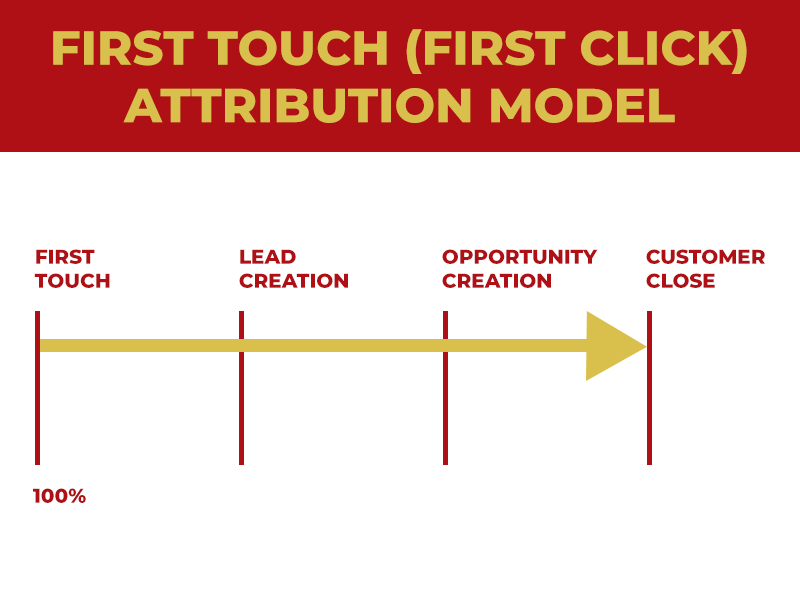
First Touch (First Click)
This attribution model refers to the first touchpoint of the marketing journey that a customer takes. For example, the first time a customer clicks on an ad they see on a social media platform, this interaction will receive all of the credit regarding attribution. It does not matter if a customer performed other activities before a purchase transaction is made, such as signing up for a newsletter. The first touch or first interaction model receives all the credit when that customer ultimately makes a purchase. The advantage of using this model is that it can help businesses that are capable of converting customers faster, as well as help companies with a short buying cycle. On the contrary, this model completely disregards other marketing efforts that customers may have engaged with before any conversions. Marketers should keep this in mind when measuring campaign success with this model.
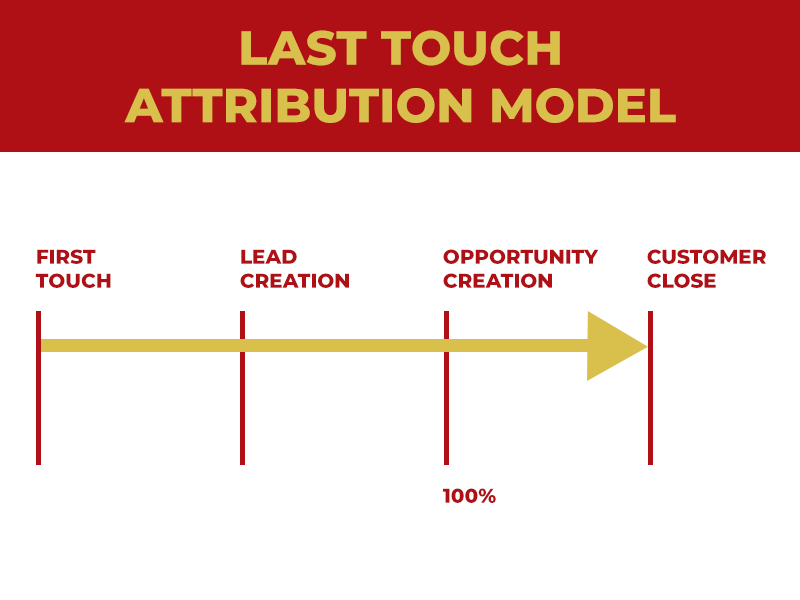
Last Touch (Lead Creation)
This attribution model refers to the last touchpoint your customer had before purchasing a product or service. For example, if your customer’s last touchpoint before the purchase was receiving information from a marketing email, this particular marketing platform will receive all attribution. Many prominent platforms utilize this model, including the popular Google Analytics. This model is a great advantage to businesses that typically have short sales cycles with almost immediate conversions. Because of those quick conversions, marketing professionals can obtain information on the last touchpoint that inspired customers to take action. A noticeable drawback of this attribution model, as well as with the first touch (first click) model, is that it gives all of the credit to just one touchpoint or interaction instead of distributing credit to other touchpoints that helped the customer create necessary action.
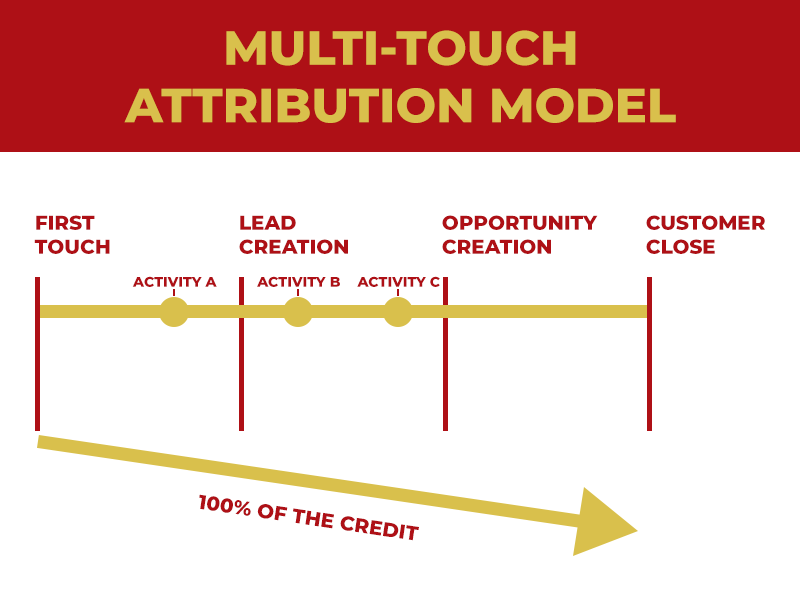
Multi-Touch
The multi-touch attribution model helps marketers understand the importance of utilizing multiple touchpoints in the purchasing journey that customers undertake. Through such models, marketers can view which touchpoints are creating a positive impact on the success of a campaign. Such models provide credit to multiple touchpoints, and the amount of credit given depends on which multi-touch models are used. For example, for a linear attribution model, each touchpoint that your customer interacted with will receive equal credit for a conversion. One disadvantage of this model is that all touchpoints will obtain the same amount of weight, meaning that even though one touchpoint had a more significant impact than a different one, all will be treated equally under the linear attribution model. Although this may be a negative aspect of this model, it is stated that approximately 32.9% of marketers generate more than twice their ROI from multi-touch marketing compared to 21.1% of single-touch users. This highlights the importance of multi-touch attribution models and how effective they can be for marketing professionals across industries.
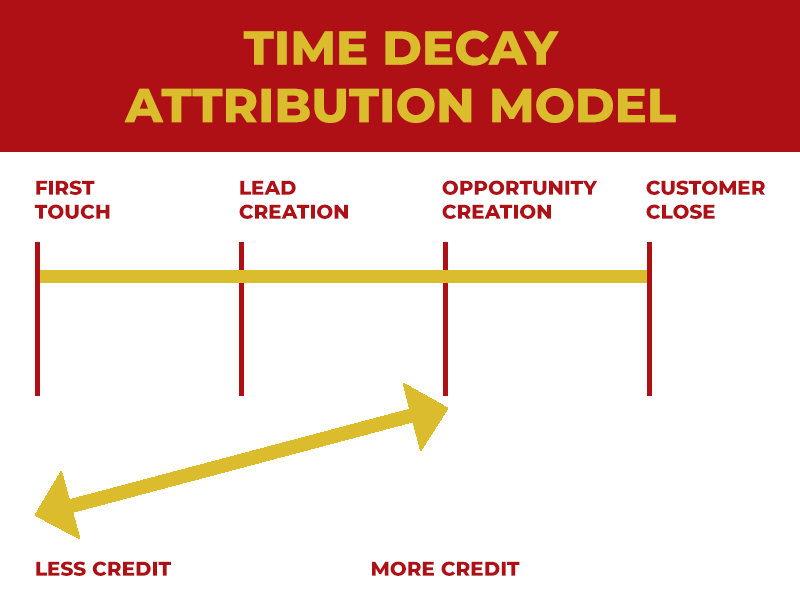
Time Decay
The time decay attribution model has similarities to a linear attribution model, such as the allocation of credit to multiple touchpoints. The difference with this particular model is that it provides more credit to the touchpoints closer to the time when the sale of goods or services occurred. Earlier interactions or touchpoints will receive the least amount of credit compared to the final touchpoints before a customer makes a purchase. If you would like to increase relationship-building strategies within your business, this attribution model can be of great assistance. One particular disadvantage that is found in the time decay attribution model is that it diminishes the impact of earlier touchpoints. The marketing platforms used on those initial touchpoints or interactions are negatively impacted by time decay attribution.
Conclusion: Choose Wisely
Many marketers still don’t have the proper knowledge of how to utilize attribution models successfully. As many as 58% of marketing teams say that their lack of knowledge regarding appropriate implementation and execution of attribution models prevents them from pursuing efforts to calculate the impact of a marketing campaign by using this technique. Another obstacle that marketers face is lack of time. About 44% of marketers say that time prevents them from performing proper execution and implementation of attribution models.
This data tells us that we need to find ways to help marketers fully understand the positive impact that attribution models can bring to the success of marketing campaigns. These models can help marketers obtain vital information regarding how customers interact with businesses and affect sales. They can also indicate if the proper marketing platforms are being used. By learning to utilize attribution models, we can then make wise decisions that can create a lasting, powerful impact to the long term success of our marketing campaigns, and ultimately affect the state of our businesses.
Learn Which Attributions Models Work Best for Your Marketing Campaigns
Are you a business owner or professional searching for more precise and error-free mechanisms to measure your marketing campaign success? At b.iD, we will create a plan that will measure the success of respective campaigns with the right attribution models specially made for your business. Give us a call. Send us an email. B.ID will gladly assist you.
Copyright © 2014-2024 b.iD LLC. All Rights Reserved.
Boutique Creative Agency providing Branding Specialists, Logo, Copywriting, Print & Web Designs, Public Relations, and Marketing solutions in Houston, Texas






